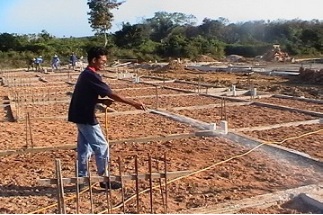Termite control in buildings is very important to avoid termite attack on building components. Anti-termite treatment is done to stop termite attack in buildings.
Termite is very harmful to any structure. It can damage the whole structure. Wooden structures are most affected by termites.
Termite enters the building through cracks in the structure or by wooden structures such as doors windows etc.

Table of Contents
Termite Control In Buildings: Explanation
Termite control in buildings involves preventing or treating infestations of termites in various structures such as homes, offices, and other buildings. These wood-destroying insects feed on cellulose-based materials and can cause significant damage to a building’s structure if left untreated.
Typically, a combination of preventative measures and treatments is implemented to effectively control termites. Preventative measures include using termite-resistant building materials, maintaining proper ventilation and moisture control, and removing wood debris and other cellulose-based materials from around the building.
Treatment options for termite infestations may include using chemical pesticides, baits, and physical barriers such as metal mesh or concrete. In some cases, a combination of these methods may be necessary to effectively eliminate the infestation and prevent future damage.
It’s important to note that a specialized field of termite control in buildings exists, and it’s recommended to hire a licensed pest control professional with experience in termite control to evaluate and treat any infestations. Regular inspections and preventative measures can also help to minimize the risk of future termite damage to buildings.
Types Of Termites
There are 3 types of termites in buildings.
1. Subterranean Termites:
Subterranean termites are the most common type of termite that infests buildings. They live in the soil and create tunnels that lead to wooden structures in buildings. They are attracted to moist wood and can cause extensive damage to buildings if left unchecked.
2. Drywood Termites:
Drywood termites live in dry wood and can infest buildings without the need for soil contact. They are less common than subterranean termites, but they can still cause significant damage to buildings.
3. Dampwood Termites:
Dampwood termites live in damp wood, such as logs and tree stumps. They are less likely to infest buildings, but they can cause damage if there is a source of damp wood inside a building.
Termite Infestation Signs
Termites are bugs that like to eat wood, but they hide inside it so we can’t always see them. However, there are some signs that can tell us if we have termites:
- Mud tubes: Termites make tubes of mud to move around, and we can find them on walls and floors.
- Discarded wings: After they find a new place to live, termites sometimes lose their wings and leave them near doors and windows.
- Hollow wood: Termites eat wood from the inside out, so if we tap on it and it sounds empty, they might be there.
- Frass: Drywood termites make tiny wood pellets that look like sawdust, and we can find them on the floor or windowsill.
- Buckling or sagging floors: If termites eat enough of the wood in a floor, it might start to bend or sink.
Anti-Termite Treatment In Buildings
In the anti-termite process, chemicals are used to kill the termites. These chemicals protect structures before construction and after construction.
Chemicals To Prevent Termite Attack
There are two chemicals used for termite control.
- Chlorpyrifos.
- Lindane 20 Ec.
These chemicals are used for both soil treatment and wood treatment. For Soil use water-emulsion
For wood, use kerosine with 1-1.5 % concentration of the given solution.
Pre-Construction Process Of Termite Control
Anti-Termite treatment is provided for soil that is excavated for the foundation. All exposed surfaces are treated with anti-termite chemicals.
For flooring, the earth’s surface is first cleaned from debris and then leveled properly. Holes of 30 cm depth at an interval of 15 cm. Water emulsion with the chemical is poured with pouring jars on the surface and in the holes.
Benefits Of Pre-construction Termite Control
- The cost is low.
- No need in the future to control termite.
- Easy before construction.
Post-Construction Process Of Termite Control
Post-construction treatment required inspection of termites in the structure and from where they are coming.
Step By Step Procedure To Stop Termite
- Establish a chemical barrier around the building.
- Treat the soil of the external wall up to 300 mm with chemical emulsion.
- Treat all the cracks in the building.
- All the palaces in the building contact with woodwork treated with chemicals.
- Treat all the electrical fixtures.
Faqs
Termites are insects that feed on wood and cause damage to buildings. They can weaken the structure and compromise its safety.
Signs of a termite infestation include mud tubes or tunnels on the walls or foundation, damaged wood, discarded wings, and visible termite droppings.
Effective methods include chemical treatments, bait stations, and physical barriers.
The effectiveness and speed of treatments can vary depending on the type of treatment and the severity of the infestation.
Preventative measures include keeping the building dry, removing wood debris, and regularly inspecting for signs of termites. Sealing cracks and openings is also important.
